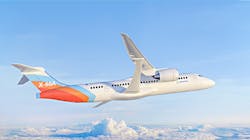RTX Raytheon selected by Boeing for X-66A NASA Sustainable Flight Demonstrator project
EAST HARTFORD, Conn., - Boeing in Arlington, Virginia, needed powerplants and related accessories for the company's X-66A flight demonstrator. They found their solution from RTX in East Hartford, Connecticut. The National Aeronautics and Space Administration (NASA) Sustainable Flight Demonstrator project, led by Boeing, chose a pair of RTX business units, Pratt & Whitney and Collins Aerospace, to support the project, including Pratt & Whitney's GTF engines and Collins nacelles and engine accessories. Pratt & Whitney and Collins will also support ground and flight tests, slated to start in 2028.
The Sustainable Flight Demonstrator is part of NASA's broader Sustainable Flight National Partnership, which is dedicated to developing the technologies needed to achieve net-zero CO2 emissions for commercial aviation. Boeing's X-66A program is focused on developing the Transonic Truss-Braced Wing (TTBW) concept, which could enable significant improvements in fuel efficiency and reduced emissions for next generation single-aisle aircraft.
"NASA's Sustainable Flight Demonstrator is a leading example of how public-private partnerships can help foster the technological breakthroughs needed to deliver on the industry-wide goal of a more sustainable, net-zero emissions future," said Geoff Hunt, senior vice president of Engineering & Technology at Pratt & Whitney. "We'll work with Boeing to apply GTF engines to the X-66A and help demonstrate the potential of its pioneering truss-braced wing design."
The GTF engine, with its geared fan architecture, delivers high fuel efficiency for single-aisle aircraft. GTF engines are certified to operate with sustainable aviation fuel (SAF) and offer up to a 75% reduction in aircraft noise footprint compared to previous generation engines.
"Collins has a long history of successful partnerships with NASA, Boeing, and Pratt & Whitney, with decades of experience pushing the boundaries of innovation in aerospace," said Dr. Mauro Atalla, senior vice president, Engineering & Technology for Collins. "Now, as part of the Sustainable Flight Demonstrator program, we will work together to demonstrate new technologies and systems to support the next generation of low-emission single-aisle aircraft that will play an integral role in reducing the environmental footprint of the aviation industry."
Collins' nacelles consist of lightweight and durable composite and metallic materials that encase the engine and serve many functions, including safeguarding the engine, controlling airflow, reducing noise and facilitating thrust reversal for deceleration during aircraft landings. In addition, Collins provides the control system components for the GTF engine, including heat exchangers, the integrated fuel pump and control, the air turbine starter and electronic controls.
